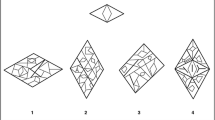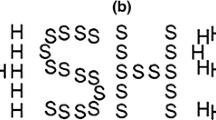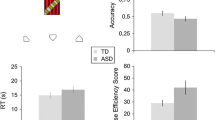Abstract
Much evidence has been gathered for differences in visual perceptual processing in individuals with Autistic Spectrum Disorder. The presence of the fundamental process of visual completion was tested in a group of children with Pervasive Developmental Disorder (PDD), as this requires perceptually integrating visual structure into wholes. In Experiment 1, it was investigated whether visual completion is present for simple partly occluded shapes in a group of children with PDD and a typically developing group. In Experiment 2, the presence of contextual influences in visual completion was investigated for the two groups. A total of 19 children with PDD and 28 controls who were matched for chronological age and IQ took part in two primed-matching tasks. For both groups, visual completion was present and for both groups, contextual influences were found to be dominant in this process. However, only for the group with PDD no priming effects (PEs) were found from less regular primes on congruent test pairs. The group with PDD did integrate visual information into wholes and did this in a contextually dependent way. However, for more complex shapes, visual completion is weaker for this group.





Similar content being viewed by others
References
APA (1994) Diagnostic and statistic manual of mental disorders (DSM-IV). American Psychiatric Association, Washington, DC
Beller H (1971) Priming: effects of advance information on matching. J Exp Psychol 87:176–182
Blake R, Turner LM, Smoski MJ, Pozdol SL, Stone WL (2003) Visual recognition of biological motion is impaired in children with autism. Psychol Sci 14:151–157
Brosnan MJ, Scott FJ, Fox S, Pye J (2004) Gestalt processing in autism: failure to process perceptual relationships and the implications for contextual understanding. J Child Psychol Psychiatr 45:459–469
Buitelaar JK, Van der Gaag RJ (1998) Diagnostic rules for children with PDDNOS and Multiplex. Developmental Disorder. J Child Psychol Psychiatr 39:911–919
Buitelaar JK, Van der Gaag R, Klin A, Volkmar F (1999) Exploring the boundaries of pervasive developmental disorder not otherwise specified: analyses of data from the DSM-IV Autistic Disorder Field Trial. J Autism Dev Dis 29:33–43
Chakrabarti S, Fombonne E (2001) Pervasive developmental disorders in preschool children. J Am Med Assoc 285(24):3093–3099
De Wit TCJ, Van Lier RJ (2002) Global visual completion of quasi-regular shapes. Perception 31:969–984
De Wit TCJ, Bauer M, Oostenveld R, Fries P, Van Lier RJ (2006) Magnetic brain responses to global and local influences in visual completion. NeuroImage 32(4):1815–1825
De Wit TCJ, De Weert ChMM, Van Lier R (2005) Luminance edges are not necessary for visual completion. Percept Psychophys 67(7):1280–1288
De Wit TCJ, Mol KR, Van Lier R (2005) Investigating metrical and structural aspects of visual completion: priming versus searching. Vis Cogn 12:409–428
Fantoni C, Gerbino W (2003) Contour interpolation by vector-field combination. J Vis 3:281–303
Frith U (1989) Autism: explaining the enigma. Basil Blackwell, Oxford
Frith U, Happé F (1994) Autism: Beyond ‘theory of mind’. Cognition 50:115–132
Gepner B, Mestre D (2002) Rapid visual-motion integration deficit in autism. Trends Cogn Sci 6:455
Happé FGE (1996) Studying weak central coherence at low levels: children with autism do not succumb to visual illusion. A research note. J Child Psychol Psychiatr 37:873–877
Happé F (1999) Autism: cognitive deficit or cognitive style? Trends Cogn Sci 3:216–222
Johnson JS, Olshausen BA (2005) The recognition of partly visible natural objects in the presence and absence of their occluders. Vis Res 45:3262–3276
Jolliffe T, Baron-Cohen S (1997) Are people with autism and Asperger syndrome faster than normal on the Embedded Figure Test? J Child Psychol Psychiatr 38:527–534
Kellman PJ, Shipley TF (1991) A theory of visual interpolation in object perception. Cogn Psychol 23:141–221
Kellman PJ, Spelke ES (1983) Perception of partly occluded objects in infancy. Cogn Psychol 15:483–524
Kourtzi Z, Kanwisher N (2001) Representation of perceived object shape by the human lateral occipital complex. Science 293:1506–1509
Milne E, Swettenham J, Hansen P, Campbell R, Jeffries H, Plaisted K (2002) High motion coherence thresholds in children with autism. J Child Psychol Psychiatr 43:255–263
Mottron L, Belleville S, Menard E (1999) Local bias in autistic subjects as evidenced by graphic tasks: perceptual hierarchisation or working memory deficit? J Child Psychol Psychiatr 40:743–755
Mottron L, Burack J (2001) Enhanced perceptual functioning in the development of autism. In Burack JA, Charman T, Yirmiya N, Zelazo PR (eds) The development of autism: perspectives from theory and research. Erlbaum, Mahwah, NJ, pp 131–148
Mottron L, Burack J, Iarocci G, Belleville S, Enns JT (2003) Locally oriented perception with intact global processing among adolescents with high-functioning autism: evidence from multiple paradigms. J Child Psychol Psychiatr 44:904–913
Navon D (1977) Forest before trees: the precedence of global features in visual perception. Cogn Psychol 9:353–383
O’Riordan MA, Plaisted KC, Driver J, Baron-Cohen S (2001) Superior visual search in autism. J Exp Psychol: Human Percept Perform 27:719–730
Ozonoff S, Strayer DL, McMahon WM, Filloux F (1994) Executive function abilities in autism and Tourette syndrome: an information processing approach. J Child Psychol Psychiatr 35:1015–1032
Plaisted K, O’Riordon M, Baron-Cohen S (1998) Enhanced discrimination of novel, highly similar stimuli by adults with autism during a perceptual learning task. J Child Psychol Psychiatr 39:765–775
Plaisted K, Swettenham J, Rees L (1999) Children with autism show local precedence in a divided attention task and global precedence in a selective attention task. J Child Psychol Psychiatr 40:733–742
Rensink RA, Enns JT (1998) Early completion of occluded objects. Vis Res 38:2489–2505
Ropar D, Mitchell P (1999) Are individuals with autism and Asperger’s syndrome susceptible to visual illusions? J Child Psychol Psychiatr 40:1283–1293
Ropar D, Mitchell P (2001) Susceptibility to illusions and performance on visuo-spatial tasks in individuals with autism. J Child Psychol Psychiatr 42:539–549
Ropar D, Mitchell P (2002) Shape constancy in autism: the role of prior knowledge and perspective cues. J Child Psychol Psychiatr 43:647–653
Schlooz WAJM, Hulstijn W, van den Broek PJA, van der Pijll ACAM, Gabreëls F, van der Gaag RJ, Rotteveel JJ (in press) Fragmented visuospatial processing in children with Pervasive Developmental Disorder. J Autism Allied Dis
Sekuler AB (1994) Local and global minima in visual completion: effects of symmetry and orientation. Perception 23:529–545
Sekuler AB, Palmer SE (1992) Perception of partly occluded objects: a microgenetic analysis. J Exp Psychol: Gen 121:95–111
Shah A, Frith U (1983) An islet of ability in autistic children: A research note. J Child Psychol Psychiatr 24:613–620
Shah A, Frith U (1993) Why do autistic individuals show superior performance on the block design task? J Child Psychol Psychiatr 34:1351–1364
Van Lier R (1999) Investigating global effects in visual occlusion: from a partly occluded square to the back of a tree-trunk. Acta Psychologica 102:203–220
Van Lier R, Van der Helm P, Leeuwenberg E (1994) Integrating global and local aspects of visual occlusion. Perception 23:883–903
Van Lier R, Van der Helm P, Leeuwenberg E (1995) Competing global and local completions in visual occlusion. J Exp Psychol: Human Percept and Perform 21:571–583
Van Lier R, Wagemans J (1999) From images to objects: global and local completions of self-occluded parts. J Exp Psychol: Human Percept Perform 25:1721–1741
Wechsler D (1974) Wechsler intelligence scale for children. Psychological Corporation, New York
Acknowledgements
TdW was funded by the Netherlands Organisation of Scientific Research (NWO) on a project awarded to RvL, WS by the Foundation for Child and Adolescent Psychiatry East Netherlands (SKJPON, Stichting Kinder- en Jeugdpsychiatrie Oost Nederland) and RvL received a grant from the Royal Netherlands Academy of Arts and Sciences. The authors would like to thank two anonymous reviewers for their helpful comments, Ilse Groenendaal en Anne Monsuwe for their assistance in testing the children and of course all children, their parents and schools for their invaluable help.
Author information
Authors and Affiliations
Corresponding author
Rights and permissions
About this article
Cite this article
de Wit, T.C., Schlooz, W.A., Hulstijn, W. et al. Visual completion and complexity of visual shape in children with pervasive developmental disorder. Eur Child Adolesc Psychiatry 16, 168–177 (2007). https://doi.org/10.1007/s00787-006-0585-9
Accepted:
Published:
Issue Date:
DOI: https://doi.org/10.1007/s00787-006-0585-9




